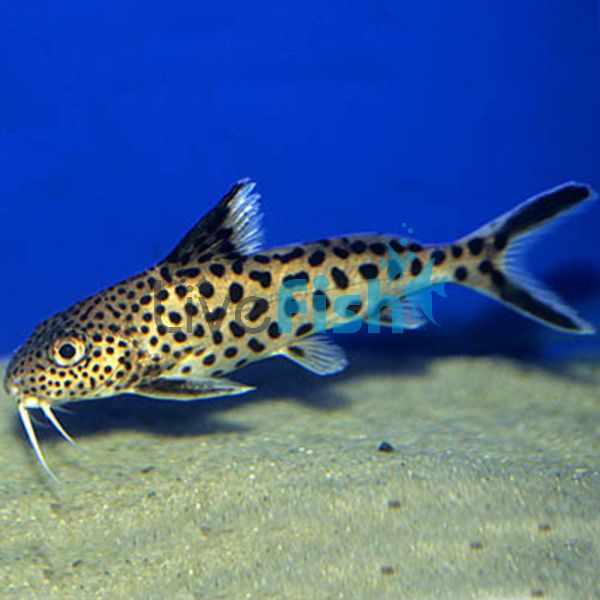Cuckoo Catfish 3cm
Cuckoo Catfish - One of the most popular catfish aside from common species such as corydoras or plecos, these cuckoo catfish are very common amongst aquarists who keep African cichlids. Cuckoo catfish are great because of their size, colours, active behavior, hardiness, and shark-like look. Cuckoo catfish are great to add in African cichlid aquariums specifically because of how they offer natural population control. These fish are known for the unique way of how they often consume eggs laid by African cichlids and place their own and it's truly an interesting display of nature in the aquarium.
- Buy 5 for $43.63 each and save 10%
- Buy 10 for $38.78 each and save 20%
Cuckoo Catfish
One of the most popular catfish aside from common species such as corydoras or plecos, these cuckoo catfish are very common amongst aquarists who keep African cichlids. Cuckoo catfish are great because of their size, colours, active behaviour, hardiness, and shark-like look. Cuckoo catfish are great to add in African cichlid aquariums specifically because of how they offer natural population control. These fish are known for the unique way of how they often consume eggs laid by African cichlids and place their own and it's truly an interesting display of nature in the aquarium.
But aside from they are peaceful fish and a great catfish to add to hardware aquariums and they have an iridescent cream colour with a slight green tinge. Along with that, they have great patterning of jet black spots which transition to full black on the fins. They also do have a great outline of white on their fins and barbells which make the fish look even more defined.
The cuckoo catfish are also great as they get into the tight gaps between rock-work and assist in the detritus which may build up to be pushed out. Cuckoo catfish are in fact found in large groups in the wild which is why in the home aquarium they should be kept. Differentiating males and females are fairly difficult and are not truly confirmed unless they are vented however this only tends to work as they get bigger. Though there are multiple species of synodontis, this species grows to a maximum size of 27 cm which means they can be kept with larger sized Africans but does also mean they need a fairly large aquarium.
Tank Recommendations for your Cuckoo Catfish
Being a larger growing and active fish, the cuckoo catfish should be kept in an aquarium that is at least 450 litres with the specific dimensions of 120cm x 60cm x 60cm. This ensures they can be kept with other tank mates and have enough space themselves. A sandy crushed coral substrate is best as it keeps the ph high and as they sift through the substrate for food it makes sure their barbels do not get damaged. They also do appreciate rock work and great options would be Texas holey rock or seriyu stone as once again these act as PH buffers. These fish are plant safe and cant be kept with a variety of plants that can survive in the high PH environment such as Anubias or java fern.
Suitable Tank Buddies
As synodontis get to almost 30cm long these fish can be kept with a. Range of larger growing and high ph fish. Their best tank mates would be African cichlids which are not small enough to potentially be eaten. They are however a bottom-dwelling species so when selecting tanks mates considerations should be made on how food can potentially reach these fish without being eaten by larger or more active tank mates higher up in the aquarium. These fish however are limited to their range of tank mates and are best kept in a species only environment or with African cichlids as seen in the wild.
Usually Compatible
African cichlids such as peacocks, mbunas and haps can all tolerate the higher PH demands.
Sometimes Compatible
Larger African fish species such as Senegal bichirs and common plecos may also be suitable.
Rarely Compatible
Any nano aquarium fish as these may potentially be eaten and many South American species which can not tolerate the 8+ ph conditions of the cuckoo catfish.
Feeding your Cuckoo Catfish
Cuckoo catfish are very easy to feed. They will take a wide range of pellets, flakes and frozen foods. Just like any fish though they should be fed a varied diet with a mix of different foods. The ideal diet would be a good quality micro slow sinking pellet or crushed flake, supplemented with frozen bloodworms or black worms or even live foods like baby brine shrimp or micro worms.
| Scientific Name | Synodontis Multipunctatus |
|---|---|
| Care Level | Easy |
| Common Names | Cuckoo Catfish, Synodontis catfish |
| Diet | Omnivore |
| Fish Family | Mochokidae |
| Lifespan (years) | 15 |
| Max. Length (cm) | 28 |
| Min. Tank Volume (l) | 450 Liters |
| Origin | Africa |
| Reef Safe | Yes |
| Sociability | Peaceful |
| Venomous | No |
| Water Conditions | 24-26° C (75.2-79° F), pH 8.0-8.5 |




